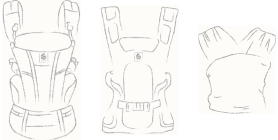Hannah Sullivan
Kangaroo Care describes a technique in which infants, often premature and underweight, are placed, skin-to-skin, on the chest of the mother or primary caregiver. This position ensures physiological and physical closeness and warmth. The stable body temperature of the parent can effectively regulate the infant’s temperature, and provides easy accessibility to breastfeeding. Even with the advanced technology in NICUs available in the United States, one recent study noted that 82% of neonatal intensive care units in the US include kangaroo care. Originally devised in in 1978, the concept of Kangaroo Care was the brainchild of Dr. Edgar Rey Sanabria, Professor of Neonatology at Universidad Nacional de Colombia, as a response to increasing mortality rates of premature and low birth weight infants. Lacking the resources for technologically advanced equipment and extra nurses and doctors, Sanabria proposed that allowing mothers to remain skin-to-skin with these fragile infants might increase their
Recently, there has become a clear distinction between co-sleeping and what experts now refer to as bed-sharing. In order to decide what is best for your family, it is important to know the difference. According to Attachment Parenting International (API), the definitions are as follows: “Co-sleeping refers to sleeping in ‘close proximity,’ which means the child is on a separate sleep surface in the same room as the parents.” “Bed-sharing, also called the ‘family bed,’ describes a sleep arrangement where the family members sleep on the same surface.” While new parents may feel pressured to have their baby “sleep through the night,” this scenario describes a myth. Frequent waking occurs for myriad reasons, and throughout most of the phases of a baby’s growth and development into childhood. Most parents find it less disruptive to sleep in close proximity to the baby, to accommodate for nighttime feeding and other needs with minimal interruption. In fact, babies often settle back into
What do you say when your child says, "No!"? Practical and immediate ways to dissolve parent/child power struggles are available through Compassionate Communication, AKA Nonviolent Communication, or NVC. There is a way to hear the “yes” underneath the “No!” and let the “No!” lead to a more satisfying connection and relationship. Marshall Rosenberg developed the heart-centered compassionate communication process that has been used successfully between parents and children, couples, gangs, religious parties, and even many war-torn countries. Relationships improve through understanding. His book, Nonviolent Communication: A Language of Life shares his compassionate communication methods through his experiences, as told in easy-to-read, clear stories that are sometimes funny, sometimes touching, and mostly amazing in their successful resolutions. “Words are windows or they’re walls, they sentence us or set us free...” These are the words sung by Marshall Rosenberg, Ph.D., in “The Basics of
Imagine that you are alone in a foreign country, with no understanding of the primary language. Without technology or books to guide you, you must navigate your way through this world. Hungry? Need a place to sleep? Where is the train? After many frustrating encounters, you might finally try using your hands to communicate. Babies and toddlers live in this world every day – they have needs that they cannot verbally express. No wonder they have tantrums! Sign language can help ease this transition from non-verbal to verbal, and, some assert, even increase the speed of language acquisition and spatial reasoning development in toddlers. As long as signing is used in conjunction with speech, it can serve to enhance a baby’s understanding of language. Once the baby can sign back, two-way communication is possible. Parents can speak as they sign (“Yes, that IS a yellow car. Did you hear it?”), and the baby learns to associate signs with words and sounds. Many parents choose to teach only the
Adopting a Newborn: Journey and Attachment Challenges
The process of adoption is often long and emotional. By the time the exhausted new parents have been united with their baby, it is time to begin the journey of becoming a family. The joy and excitement of this new beginning, however, can sometimes conceal a very real challenge: how to form a strong attachment with this unfamiliar baby?
Understanding Attachment Difficulties When Adopting a Newborn
According to Dr. Walter D. Buenning, Ph.D. and expert in treating Reactive Attachment Disorder, 10-30% of infants adopted at birth may have trouble attaching to their adoptive parents. While there is little research to determine the exact cause of an infant’s difficulty in attaching, this behavior is usually associated with early trauma: neglect, abuse, abandonment, or multiple placements.
Effective Strategies to Encourage Attachment
Lacking a specific “cure for difficult attachment, experts agree on a few behaviors that parents can implement
...I once told a group of environmental activists, "You can save a forest today, but if we don't raise children consciously, it will be cut down tomorrow." From this perspective we see that the well being of children sits at the root of every endeavour. With out happy, healthy children, we have no forest, no peace, and no world.
A powerful body of research grounded in the fields of neuroscience, psychology, biology and genetics points us towards the importance of the early years and how bonding, or the lack of it, dictates a child's sense of his relationship to the world and himself. We as parents literally have in our hands, the ability to create a violent culture or a peaceful one.
(* Ecologist and Editor of Kindred magazine, one of the world's most endorsed parenting journals, Kali Wendorf is a passionate advocate of social change; particularly as it relates to the role of parents in our society. She feels that any movement to address any of our society's woes, including climate change
























